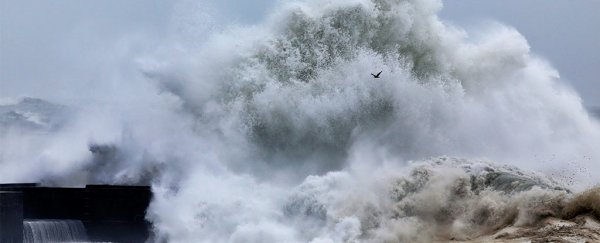A rare and extreme tsunami ripped across an Alaskan fjord three years ago after 180 million tons (163 million tonnes) of mountain rock fell into the water, driving a devastating wave that stripped shorelines of trees and reached heights greater than 600 feet (182 metres), a large team of scientists documented on Thursday.
The October 2015 cataclysm in Taan Fiord in southeastern Alaska appears to have been the fourth-highest tsunami recorded in the past century, and its origins - linked to the retreat of a glacier - suggest that it's the kind of event we may see more often because of a warming climate.
The new study even bluntly calls it a "hazard occasioned by climate change".
"More such landslides are likely to occur as mountain glaciers continue to shrink and alpine permafrost thaws," the authors, led by geologist Bretwood Higman of Ground Truth Trekking, write in Nature Scientific Reports.
"Thirty-odd, 40 years ago, Taan Fiord didn't exist at all. It was filled with ice," added Dan Shugar, a geoscientist at the University of Washington in Tacoma and another of the study's 32 authors, who hail from institutions in the United States, Canada and Germany.
But the glacier, Tyndall Glacier, retreated backward about 10 miles (16 kilometres) between 1961 and 1991, while thinning out by more than 1,000 feet (300 metres), before stabilizing at its current location.
That hasn't merely opened up the fjord; it has also removed a very large ice mass that had braced and supported its mountain walls, the research said.
When the massive rockslide occurred just in front of the glacier, the confined shape of the fjord led to the truly gigantic resultant wave, which traveled as fast as 60 miles per hour (96.5 km/h).
"Imagine dropping a bowling ball into your bathtub," Shugar said.
"The water can go to every side of the bathtub. But when it hits the side of the bathtub, it can't go any more. So the only way it can go is up."
Shugar said that the tsunami was not the biggest known, but that it's in the same genre.
"The biggest that's ever been recorded was actually just down the Alaskan road, in Lituya Bay, and it was a remarkably similar kind of event, a landslide came down, hit the terminus of a glacier, and went into the fjord water itself," he said.
"In that case, it was preceded by a large earthquake."
That wave reached 1,719 feet (523 metres) in 1958. There's no telling, of course, what kind of violent events the Earth may have produced in the more distant past, but it's likely that there were tsunamis more extreme still.
To document the 2015 tsunami, the scientists arrived relatively quickly on the scene, scientifically speaking, after detecting the initial landslide's seismic signature - eight months later.
They proceeded to study the wreckage, detecting shorelines scoured of vegetation, large pileups of rock and debris, and even smaller rocks driven deep into tree trunks, almost as though they were hit by a shotgun blast.
No one was present or injured, but Shugar says he's worried about the possibility that a cruise ship might find itself in an Alaskan fjord during some future extreme event. He also points out that a recent, similarly caused tsunami in Greenland led to four deaths.
In other words, this isn't the only event of its kind, and we can expect more types of extremes as massive glaciers retreat and the mountains around them respond.
"As the mountain slopes adjust to the new conditions, they may release single rocks, rock avalanches or fail entirely," said Martin Lüthi, a geographer at the University of Zurich who recently documented a smaller tsunami in a Greenland fjord caused by ice falling, rather than rock, but was not involved in the current study.
"Several very big landslides have happened in areas of rapid deglaciation worldwide, and triggered big tsunami waves when they reached lakes or fjords."
"The authors are certainly right with their proposal to identify, map and monitor potential danger zones to mitigate future damage through landslide-generated large tsunamis," Lüthi added.
"Their interpretations of the role of glacier retreat in creating the hazard setup are compelling as well as chilling," added Ronadh Cox, a geoscientist at Williams College in Massachusetts who has studied the power of extreme waves to move rock and other large objects.
"This appears to me to be a landmark study."
Tsunamis and avalanches aren't the only hazards caused by glacial retreat. Melting mountain glaciers also can leave large lakes at high altitudes; these lakes can then suddenly drain, cascading down slopes.
For glaciers sitting in deep water or near it, meanwhile, large pieces of ice breaking off can also create waves in fjords.
Ultimately, the event just documented in Taan Fiord shows the mega-scale at which climate change is altering landscapes - and the matching scale of the consequences.
"The issue is, as we're creating more of these steep slopes, we have the potential to generate more of these events," Shugar said.
2018 © The Washington Post
This article was originally published by The Washington Post.
